Have you noticed your pregnancy bump has started to look like a cone?
Are you wondering why it’s happening?
Coning during pregnancy is quite common and could signify that your abdominal muscles are separating.
After reading this post, you’ll learn:
- What coning is,
- Why do some women develop a cone-shaped abdomen, and
- What you could do to fix it.
Let’s jump right in.
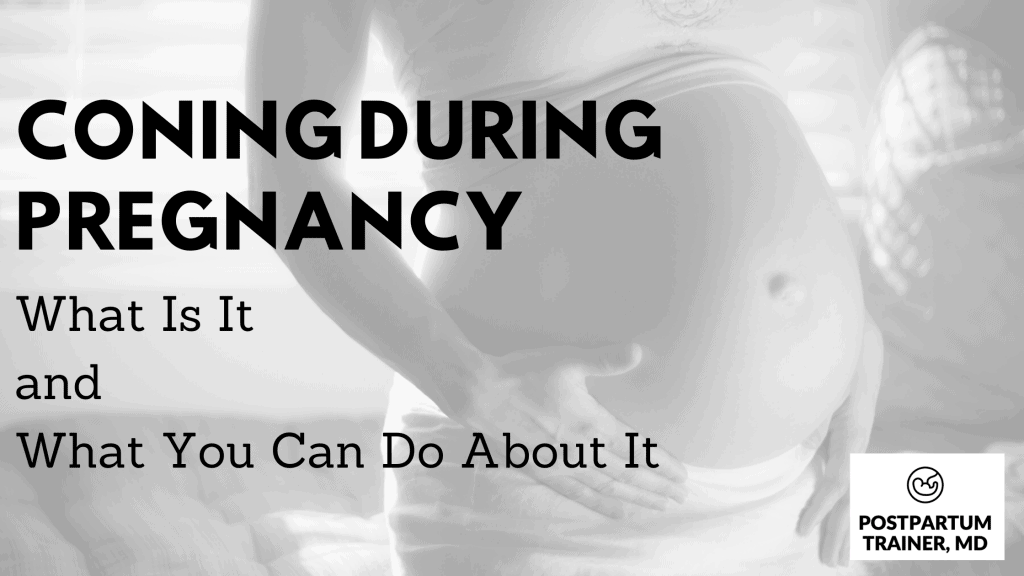
Why does my pregnant belly look like a cone?
Coning during pregnancy occurs when the connective tissue in your abdomen bulges out along the midline in a cone shape.
Often, coning is a sign of ab muscle separation (diastasis recti) and decreased core strength.
Any activity that increases intra-abdominal pressure can cause your abdominal organs to protrude, leading to coning.
Coning in pregnancy has many names, such as:
- torpedo belly
- doming
- pointy bump
- pointy belly
Is coning in pregnancy normal?
Coning in pregnancy is very common and usually due to diastasis recti and improper management of your intrabdominal pressure.
If your abdomen assumes the shape of a cone when doing certain activities, you should avoid that specific activity.
Instead, you should focus on learning how to activate your deep core muscles.
More on that later.
Does everyone get coning during pregnancy?
Not every woman pregnant woman will develop coning. However, it is very common to lose strength in your mid-section during pregnancy, especially true if you don’t train your core regularly.
In the second and third trimesters, the growing uterus exerts pressure on the abdominal wall and causes all the tissues around it to stretch.
The stretching is most prominent in your ab muscles which include:
- Transverse abdominis
- Obliques, and
- Rectus abdominis (the 6-pack muscles)
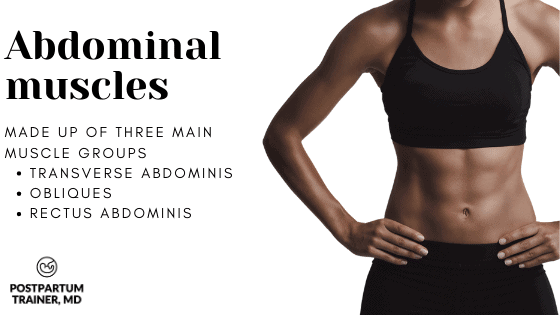
Normally, your abdominal muscles and fascia keep all your intrabdominal organs in place.
When these muscles are stretched and weakened, the abdominal tissue underneath can bulge outward.
Is coning bad during pregnancy?
Activities that increase coning place significant stress on the linea alba, the connective tissue that sits between your rectus abdominis muscle.
As your uterus continues to grow, improper management of your intra-abdominal pressure can further weaken this area. This is one of the reasons why you develop diastasis recti (aka ab separation).
Long term risks may include:
- Umbilical Hernia: When internal organs like your small bowel herniate through a defect or weak area in your abdomen
- Pelvic Floor Dysfunction: Increasing your risk of urinary incontinence and pelvic organ prolapse
- Lower Back Pain & Posture Problems: Postural changes at the hips are a major cause of musculoskeletal pain and injury
How do you fix coning when pregnant?
The most important thing is to avoid any exercise that causes coning or bulging of your abdomen.
Common exercises to avoid include:
- Full push-ups.
- Full plank variations.
- Hanging from a bar.
- Sitting up from a lying position.
Instead, you need to perform exercises that activate and strengthen your deep core muscles.
Those muscles include your:
- pelvic floor
- transverse abdominis, and
- diaphragm
One of the easiest and most effective exercises to activate a weak core during pregnancy is deep diaphragmatic breathing.
Here is what the exercise looks like from a quadruped position:
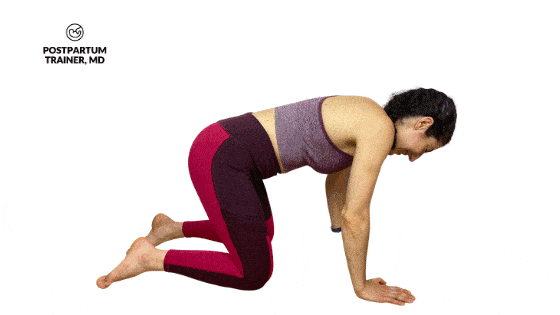
And here’s how it looks from a seated position:

When performing the deep breathing ab exercise, it is essential to keep your shoulders relaxed when inhaling.
Your belly should be the only area that moves.
Filling up your belly allows for maximum expansion of the lungs and maximum contraction of the diaphragm.
The exhalation is also very important.
Focus on squeezing and engaging your abs and pelvic floor on the exhalation.
Once you learn this essential movement pattern, you can then use it while training other transverse abdominis ab exercises.
Check out my post on 18 safe transverse ab exercises to learn more.
Other Related Questions
When does coning start?
Coning typically starts in the late second trimester of pregnancy, when the uterus grows rapidly.
However, some women may not notice a difference until the third trimester.
Do abs always separate during pregnancy?
The majority of pregnant women will experience abdominal muscle separation.
One study found that 100% of 84 women had ab muscle separation. Another study saw a 60% prevalence at six weeks postpartum in 300 women.
It makes sense.
Your rectus abdominis and linea alba sit right on top of the uterus.
As your uterus grows to support your growing baby, the linea alba stretches, leading to the separation of the rectus abdominis muscles.
What does Diastasis Recti look like while pregnant?
If you have diastasis recti during pregnancy, your abdomen may look like a cone when doing exercises that place high tension on your abdomen.
For example, when you get up from a lying position (a crunch), you may notice a cone shape in your abdomen.
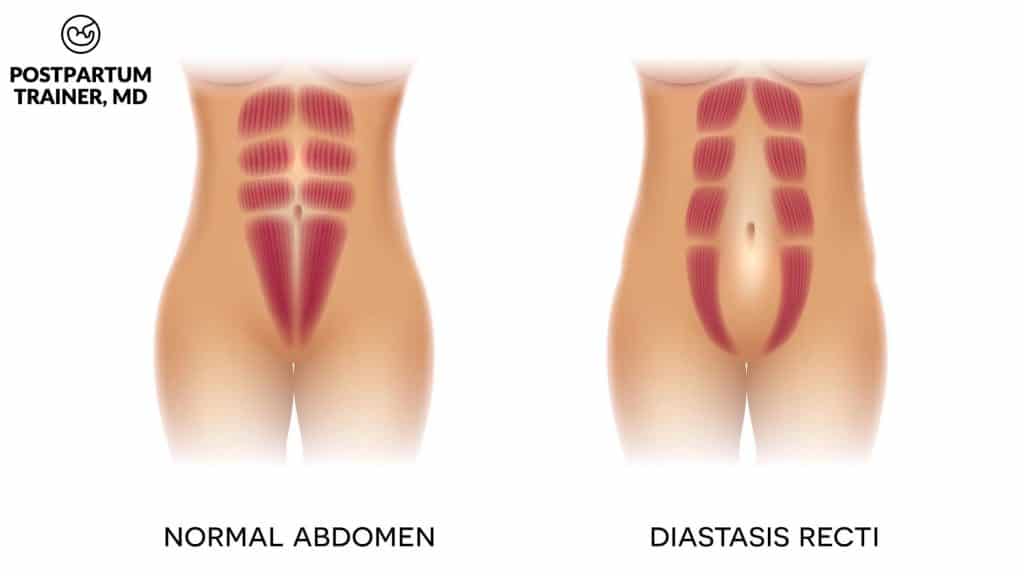
How do you tell if you’re getting Diastasis Recti while pregnant?
If you have a very gravid uterus, it may be difficult to tell if you are getting diastasis recti.
If you aren’t yet in the late second trimester, there is a simple test you could do at home to determine if you are developing, or already have developed diastasis recti.
It’s called the wall curl test, and it looks like this:
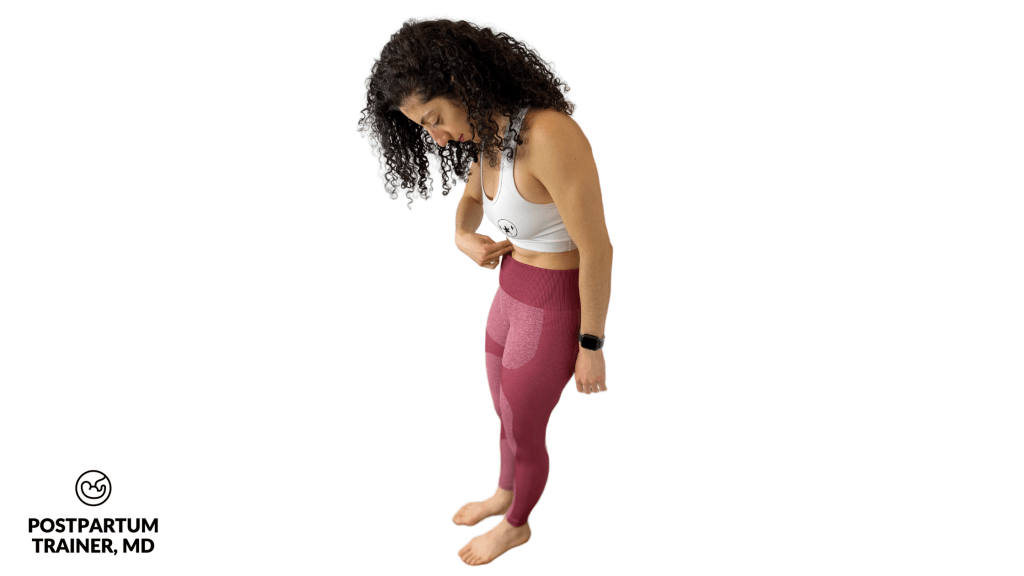
To do this exercise:
- Stand along the wall with your knees straight and feet flat on the floor.
- Next, perform a pelvic tilt to flatten your lower back against the wall. (Pelvic tilts are another great way to train your deep abdominal muscles)
- Use your right hand to place your pointer and middle fingers above your belly button.
- If your abdominal muscles have separated, you will feel squishy contents and will be able to stick your fingers inside.
- Generally speaking, most experts agree that an abdominal gap of 2 fingers widths is diagnostic.
How can I prevent coning and diastasis during pregnancy?
The best way to prevent diastasis recti during pregnancy is to strengthen the core muscles before becoming pregnant. In addition, you should continue to train them during pregnancy as well.
A systematic review published in 2013 on over 330 women found that exercise in the antenatal period reduced the risk of developing diastasis recti by about 35%!
Remember, you must get clearance from your doctor before doing any exercise- especially during pregnancy.
Also, make sure that you avoid any exercise where you are flat on your back or stomach (particularly in the 2nd and 3rd trimester.)
I have an entire post on preventing diastasis recti here.
Is it possible to coning and not be pregnant?
Coning and diastasis recti can also occur outside of pregnancy. Other common causes of diastasis recti include:
- Obesity and excessive weight gain
- Experiencing repetitive strain in the abdomen (such as excessive coughing and vomiting)
- Excessive use of heavy weights
- Having a connective tissue disorder
Final Words On Coning & Diastasis Recti During Pregnancy
Diastasis recti and coning is very common in pregnancy and happens to many women.
Fortunately, there are exercises you can do throughout your pregnancy to strengthen your core and minimize any negative consequences of coning and abdominal separation.
As always, just make sure you receive clearance from your doctor before working out.
Now I want to hear from you.
Did your belly take on the shape of a cone during your pregnancy?
What did you do?
Comment below and let me know.
Related Posts:
- 100 Effective Diastasis Recti Exercises For New Moms
- How To Tell If You Have Diastasis Recti Postpartum
- 21 Safe Core Exercises You Can Do In Pregnancy
Get Four Free Workouts To Help Strengthen Your Pelvic Floor & Heal Your Mommy Tummy!

Brittany Robles, MD, MPH, CPT
Brittany Robles is a full-time OBGYN physician, a NASM certified trainer, and a prenatal and postnatal fitness specialist. She holds a Master of Public Health degree in maternal health with a special interest in exercise and nutrition. She is also the co-author of The White Coat Trainer. Learn more about her here.
Sharing is Caring – Send This To A Mom In Need!
References:
- Fernandes da Mota PG, Pascoal AG, Carita AI, Bø K. Prevalence and risk factors of diastasis recti abdominis from late pregnancy to 6 months postpartum, and relationship with lumbo-pelvic pain. Man Ther. 2015 Feb;20(1):200-5. doi: 10.1016/j.math.2014.09.002. Epub 2014 Sep 19. PMID: 25282439.
- Sperstad JB, Tennfjord MK, Hilde G, Ellström-Engh M, Bø K. Diastasis recti abdominis during pregnancy and 12 months after childbirth: prevalence, risk factors and report of lumbopelvic pain. Br J Sports Med. 2016 Sep;50(17):1092-6. doi: 10.1136/bjsports-2016-096065. Epub 2016 Jun 20. PMID: 27324871; PMCID: PMC5013086.
- Benjamin DR, van de Water AT, Peiris CL. Effects of exercise on diastasis of the rectus abdominis muscle in the antenatal and postnatal periods: a systematic review. Physiotherapy. 2014 Mar;100(1):1-8. doi: 10.1016/j.physio.2013.08.005. Epub 2013 Oct 5. PMID: 24268942.

I am a 69 year old male that has developed a DIASTASIS RECTI HERNIA. THE ONLY CAUSE WE COULD THINK OF WOULD BE MIGHT BE OVERWEIGHT AND BEING ON ORAL STEROIDS FOR A FEW YEARS MIGHT HAVE WEEKENDS MY ABDOMINAL WALL.